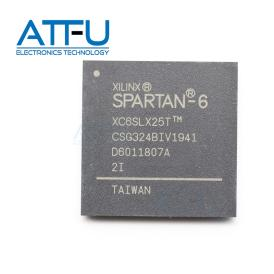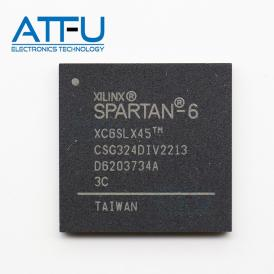Introduction
In the high-stakes world of defense and military operations, technology stands as the fulcrum of power. Electronic components, the often-overlooked backbone of these operations, facilitate critical functions, from communication and navigation to radar systems and missile guidance. This article embarks on a journey through the electronic components vital to defense and military applications, spotlighting renowned brands such as Intel, Xilinx, and Microchip. Additionally, we’ll delve into specific models like the ATXMEGA128A1-AU, XC6SLX16-3FTG256I, and XC6SLX45-3CSG324C, as well as the indispensable Field-Programmable Gate Arrays (FPGAs) and Digital Signal Processors (DSPs).

Defense and Military Applications: The Crucial Role of Electronics
In the world of defense and military applications, technological superiority is the key to success. Electronic components serve as the lifeblood of these high-stakes systems, underpinning capabilities that span secure communications, precision navigation, advanced radar, and missile guidance. Cutting-edge electronics are instrumental in maintaining supremacy in a landscape marked by rapid change and evolving threats.

In the realm of defense and military electronics, several brands have etched their names as pioneers, leaving an indelible mark on the sector. These standout players have consistently pushed the boundaries of innovation, delivering cutting-edge solutions that redefine military capabilities. From Intel’s computational prowess to Xilinx’s field-programmable gate arrays (FPGAs) and Microchip’s robust microcontrollers, these brands have fortified national security and enabled military forces worldwide to achieve unparalleled levels of effectiveness, resilience, and adaptability in the face of evolving threats. Their contributions continue to shape the defense landscape, safeguarding nations and enhancing global security.
Intel, synonymous with computing, has a strong presence in the defense sector. Their processors and chipsets provide the computational muscle for advanced command and control systems, secure communications networks, and data analytics tools.
Xilinx, a trailblazer in FPGA technology, has left an indelible mark on military applications. Their FPGAs, prized for their adaptability and computational prowess, enable the creation of customized, high-performance digital circuits that can swiftly adapt to evolving mission demands.
Microchip
Microchip’s microcontrollers and integrated circuits play a pivotal role in defense systems, powering tasks ranging from embedded control and sensor interfacing to secure communication.
Unveiling the Core Electronic Components
Let’s embark on a deeper exploration of the electronic components that form the very lifeblood of defense and military applications. These critical components, including the ATXMEGA128A1-AU microcontroller, XC6SLX16-3FTG256I and XC6SLX45-3CSG324C field-programmable gate arrays (FPGAs), and digital signal processors (DSPs), are the technological nerve center of military systems. They empower everything from communication and surveillance to weaponry and logistics, ensuring the armed forces operate with precision and effectiveness.
ATXMEGA128A1-AU Microcontroller
The ATXMEGA128A1-AU, a jewel in Microchip’s portfolio, is a microcontroller tailored specifically for industrial and military applications. Renowned for its formidable processing capabilities, rugged architecture, and energy efficiency, it finds its calling in control systems, data logging, and sensor interfacing in military equipment.
XC6SLX16-3FTG256I FPGA
Xilinx’s XC6SLX16-3FTG256I is an FPGA celebrated for its adaptability and raw computational power. FPGAs are the bedrock of defense systems, offering the flexibility to customize digital logic in real time, adapting swiftly to changing mission parameters. These components are pivotal in applications such as radar signal processing and secure communications.
XC6SLX45-3CSG324C FPGA
Another star from Xilinx’s constellation, the XC6SLX45-3CSG324C, raises the bar with even greater computational capabilities. Its flexibility, coupled with the ability to handle complex algorithms, makes it a mainstay in advanced defense systems, including missile guidance and image processing for unmanned aerial vehicles (UAVs).



FPGAs: The Key Enabler
Field-Programmable Gate Arrays (FPGAs) are the linchpin of defense and military applications. Here’s why they are indispensable:
– Customization: FPGAs can be programmed and reprogrammed on the battlefield, facilitating real-time adaptations to mission requirements and the integration of new capabilities.
– Parallel Processing: FPGAs excel at parallel processing, a critical feature for real-time signal processing, cryptography, and data compression.
– Low Latency: FPGAs ensure low-latency data processing, guaranteeing swift responses for mission-critical military functions.
– Redundancy: FPGAs can be employed to create redundant systems, enhancing reliability and fault tolerance.
DSPs: The Silent Powerhouses
Digital Signal Processors (DSPs) are equally vital in defense and military applications, offering:
– Signal Processing Mastery: DSPs are adept at processing digital signals in real time, making them indispensable for tasks like radar signal analysis, image processing, and audio manipulation.
– Efficiency: DSPs are highly efficient at executing specific mathematical and signal processing algorithms, enabling swift and accurate data analysis.
– Power Efficiency: Designed for power efficiency, DSPs are perfect for applications where minimizing power consumption is paramount.
Aerospace Applications: The Skyward Reach
Aerospace applications in the defense and military realm demand state-of-the-art electronics for tasks like navigation, communication, surveillance, and missile guidance. Electronic components are the unsung heroes, ensuring precision and reliability.
Navigation Systems: GPS receivers, gyroscopes, accelerometers, often coupled with FPGAs and DSPs, deliver pinpoint navigation and guidance capabilities for aircraft and missiles.
Communication: Secure, high-speed data communication is the lifeblood of aerospace applications. Advanced processors and communication modules facilitate real-time data exchange between military assets.
Radar and Surveillance: Cutting-edge radar systems rely on FPGAs for real-time signal processing, detecting and tracking potential threats in the airspace.
Missile Guidance: FPGAs and DSPs serve as the brains behind missile guidance systems, ensuring precise targeting and interception of incoming threats.
Conclusion
In the ever-evolving realm of defense and military applications, electronic components step into the spotlight as the silent architects of security and national defense. Brands such as Intel, Xilinx, and Microchip have carved their names as trailblazers in this pivotal sector, leaving an indelible mark through their cutting-edge components.
The likes of the ATXMEGA128A1-AU microcontroller, XC6SLX16-3FTG256I, and XC6SLX45-3CSG324C FPGAs serve as the lifeblood of these systems, endowing them with unparalleled capabilities. Field-Programmable Gate Arrays (FPGAs) and Digital Signal Processors (DSPs) stand as the bedrock, empowering peak performance across applications spanning communication, surveillance, and missile guidance.
In the relentless march of technology, electronic components will remain at the forefront of innovation. They guarantee that defense and military systems remain versatile and resilient in the face of evolving global challenges. Beyond their tangible forms, these components embody human ingenuity, facilitating the defense of nations and the preservation of our cherished way of life. In a world of constant change, they stand as a symbol of our unwavering dedication to security, ushering in an era where defense and military capabilities continuously redefine the limits of possibility.

